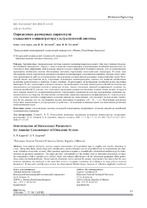| dc.contributor.author | Луговой, В. П. | ru |
| dc.contributor.author | Луговой, И. В. | ru |
| dc.coverage.spatial | Минск | ru |
| dc.date.accessioned | 2018-02-09T08:30:40Z | |
| dc.date.available | 2018-02-09T08:30:40Z | |
| dc.date.issued | 2018 | |
| dc.identifier.citation | Луговой, В. П. Определение размерных параметров кольцевого концентратора ультразвуковой системы = Determination of Dimensional Parameters for Annular Concentrator of Ultrasonic System / В. П. Луговой, И. В. Луговой // Наука и техника. – 2018. – № 1. - С. 51-55. | ru |
| dc.identifier.uri | https://rep.bntu.by/handle/data/37525 | |
| dc.description.abstract | Традиционные ультразвуковые системы содержат концентраторы продольного типа для усиления и передачи колебаний инструменту. Наряду с ними в качестве концентраторов ультразвуковых колебаний акустических систем могут быть эффективно использованы упругие кольца с переменной толщиной сечения. Для их практического применения необходима научно обоснованная методика определения геометрических параметров. В статье дано обоснование методу определения размеров кольцевых концентраторов с переменным сечением, которые могут повысить эффективность работы ультразвукового оборудования для выполнения различных технологических задач. Визуальный анализ акустических волн, излучаемых кольцевыми концентраторами, показал, что наиболее интенсивные колебания возбуждаются в наиболее тонких сечениях. Компьютерное моделирование колебаний колец наружным диаметром 50 мм с переменным сечением показало, что наибольшее усиление амплитуды колебаний достигается при определенном соотношении толщин и диаметров кольца. Анализ численных значений коэффициента усиления амплитуды колебаний Кд показал, что существует предельная граница соотношения толщин стенок кольца, которая в свою очередь зависит от соотношения наружного и внутреннего диаметров кольца при определенных значениях эксцентриситета оси отверстия. Количественно соотношение диаметров выражается коэффициентом Кд. Анализ результатов численных расчетов коэффициента усиления амплитуды, выполненных для указанной модели кольца диаметром 50 мм, показал, что это соотношение должно находиться в пределах 1,30 > Кд > 1,15. Полученные результаты могут быть использованы в ультразвуковых устройствах с кольцевыми концентраторами для выполнения различных технологических задач. | ru |
| dc.language.iso | ru | ru |
| dc.publisher | БНТУ | ru |
| dc.title | Определение размерных параметров кольцевого концентратора ультразвуковой системы | ru |
| dc.title.alternative | Determination of Dimensional Parameters for Annular Concentrator of Ultrasonic System | en |
| dc.type | Article | ru |
| dc.identifier.doi | 10.21122/2227-1031-2018-17-1-51-55 | |
| local.description.annotation | Conventional ultrasonic systems contain concentrators of longitudinal type to amplify and transfer vibrations to a tool. Along with them, elastic rings with variable cross section thickness can be used effectively as concentrators for ultrasonic vibrations of acoustic systems. Their practical application requires a scientifically substantiated methodology for determination of geometric parameters. The paper provides substantiation of the method used to determine dimensions of annular concentrators with a variable cross section which can enhance effectiveness of the ultrasound equipment while performing various technological tasks. Visual analysis of acoustic waves radiated by annular concentrators has shown that the most intensive vibrations are produced in the most thin sections. Computer simulation of oscillations in rings with an external diameter of 50 mm and a variable cross section has demonstrated that the largest increase of vibration amplitude is achieved at a certain ratio of ring thicknesses and diameters. An analysis of numerical values for amplication factor of vibrational amplitude Kд has revealed that there is a limit boundary for the ratio of ring wall thicknesses which, in its turn, depends on the ratio of ring outer and inner diameters at certain values of hole axis eccentricity. The ratio of diameters is expressed quantitatively by the coefficient Kд. An analysis of the results concerning numerical calculations of amplitude amplification factor performed for the specified model of the ring having 50 mm diameter have illustrated that this ratio should lie between 1.3 > Kд > 1.15. The obtained results can be used in ultrasonic devices with annular concentrators in order to perform various technological tasks. | en |

